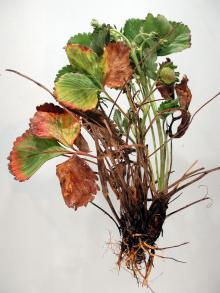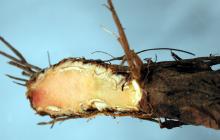See:
Strawberry (Fragaria spp.) - Leather Rot
Strawberry (Fragaria spp.) - Red Stele
Cause The fungal-like organism Phytophthora cactorum causes a rot of the strawberry crown. It appears to be different from the same fungus that causes leather rot. Oospores form in old crown tissue and survive long periods in the soil. In the spring under saturated soil conditions, zoospores are formed that infect through wounds. The disease is favored by warm temperatures and wet conditions. The cultivar Sweet Bliss appears to be very susceptible, as are many other cultivars.
Symptoms Young leaves may become off-colored and wilt suddenly. The entire plant may wilt soon after, collapse and die. If the plant is pulled out the crown breaks leaving the main crown and roots in the ground. The vascular system of the crown is discolored with dark shades of brown. Roots remain healthy if this is the only problem with the plant. Sublethal infections can also result in stunting and reduced yield.
Cultural control
- Use certified plants only. Resistant cultivars are available.
- Set new plants in well-drained soil (no standing water in winter) where red stele has not been known.
- Plant on beds raised 8 to 10 inches to improve drainage, or use drain furrows. In home gardens or small plantings, raise the bed 15 inches.
- Preplant soil solarization has been helpful in reducing populations of certain soilborne pathogens and weeds in western Oregon. Place clear plastic (preferably anti-condensation film) directly on smooth, rototilled ground, which has been irrigated to field capacity and then allowed to drain for 1-2 days. Bury the edges of the plastic to trap the heat. Solarize for 4-6 weeks (or longer) during the hottest part of the summer, beginning in early- to mid-July. Use in combination with other techniques.
- Do not plant in draws or swales where surface water flows after heavy rains.
- Chisel or subsoil 18- to 20-inches deep between rows in late fall to increase drainage.
- Clean soil from equipment before using it in other fields.
- Heat treatment of transplants prior to planting may be useful in some situations. Preheat plants at 99°F for an hour then move to 111°F for 4 hours.
Chemical control Alternate between chemicals with different modes of action to prevent or delay building up resistant microorganisms. Ressitance to FRAC 4 fungicides has been reported in southeast USA. The FRAC 4 and FRAC P7 fungicides used to manage Phytophthora do not kill this organism. They can only prevent establishment of the organism before it gets into the plant. They can also prevent continued growth if the organism is already inside the plant, thereby delaying symptoms that might have developed. Once chemical activity has subsided with time, the organism can resume growth within infected plants.
- Agri-Fos at 1.25 to 2.5 quarts/A. Group P7 fungicide. 4-hr reentry. WA only.
- Aliette WDG at 2.5 to 5 lb/A. Do not use with adjuvants. Apply when plants resume growth in spring; continue at 30- to 60-day intervals. Can be applied on day of harvest but with a 12-hr preharvest interval. Do not apply within 30 days of harvest in British Columbia. Group P7 fungicide. 12-hr reentry.
- Fosphite at 1 to 3 quarts/A. Do not use copper products within 20 days of treatment and do not use spray adjuvants. Group P7 fungicide. 4-hr reentry.
- MetaStar 2E at 2 quarts/A. Group 4 fungicide. 48-hr reentry.
- Orondis Gold at 20 to 62 fl oz/A as a drip application through irrigation water. Do not use within 28 days of harvest. Group 4 + 49 fungicide. 48-hr reentry.
- OxiPhos at 2.5 to 5 quarts/A as a foliar spray. Group P7 fungicide. 4-hr reentry.
- Phostrol at 2.5 to 5 pints/A. Group P7 fungicide. 4-hr reentry.
- Rampart at 1 to 3 quarts/100 gal water/A. Group P7 fungicide. 4-hr reentry.
- Ridomil Gold SL at 1 pint/A. Apply once at planting and again in spring as plants begin to grow. Apply again in fall after harvest but before fall rains. May be applied up to and including day of harvest. Only the fall application is allowed in British Columbia, before November 30. Group 4 fungicide. 48-hr reentry.
References Marin, M. V., Seijo, T. E., Baggio, J. S., Whitaker, V. M. and Peres, N. A. 2023. Resistance of strawberry cultivars and the effects of plant ontogenesis on Phytophthora cactorum and P. nicotianae causing crown rot. Plant Disease, 107:651-657.
Marin, M. V. and Peres, N. A., 2021. Improving the toolbox to manage Phytophthora diseases of strawberry: searching for chemical alternatives. Plant Health Progress, https://doi.org/10.1094/PHP-02-21-0034-FI.



